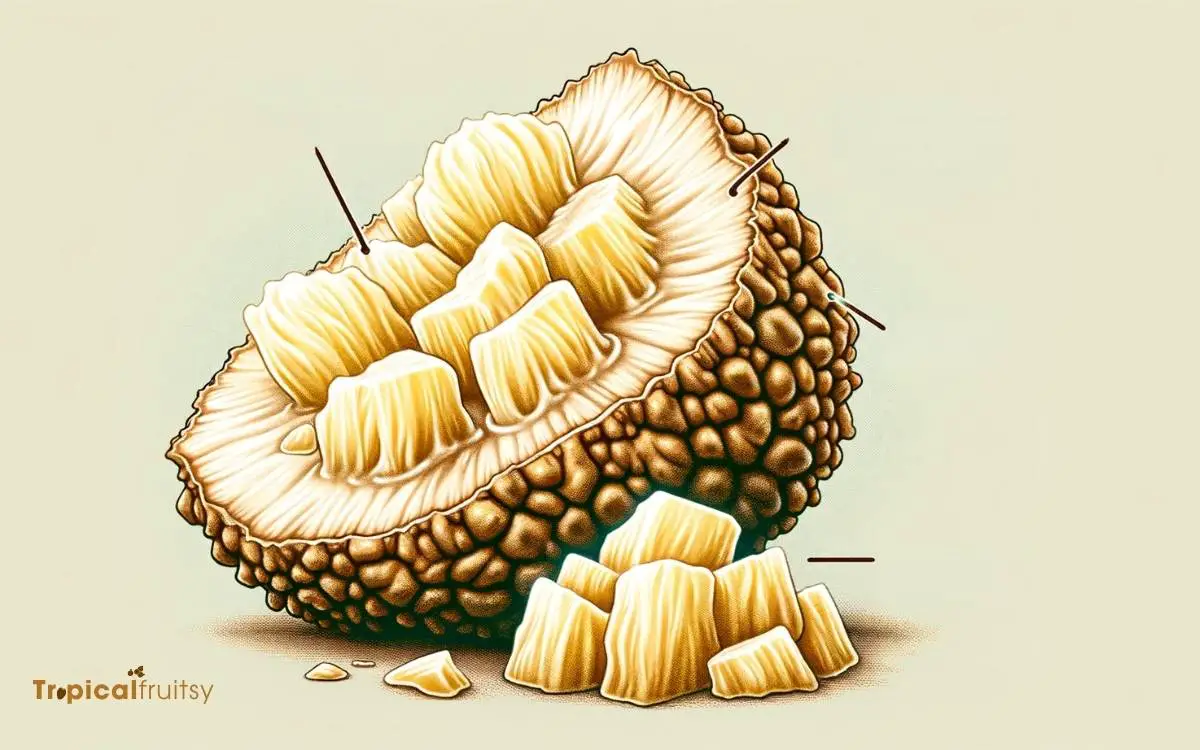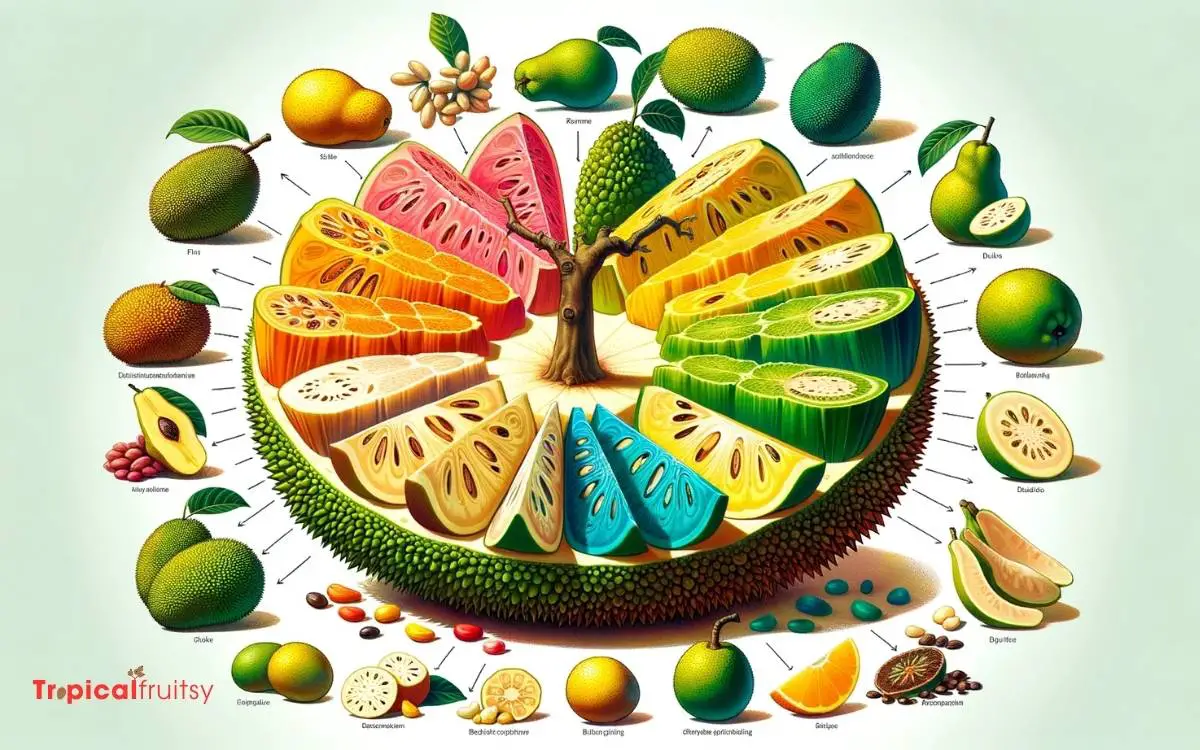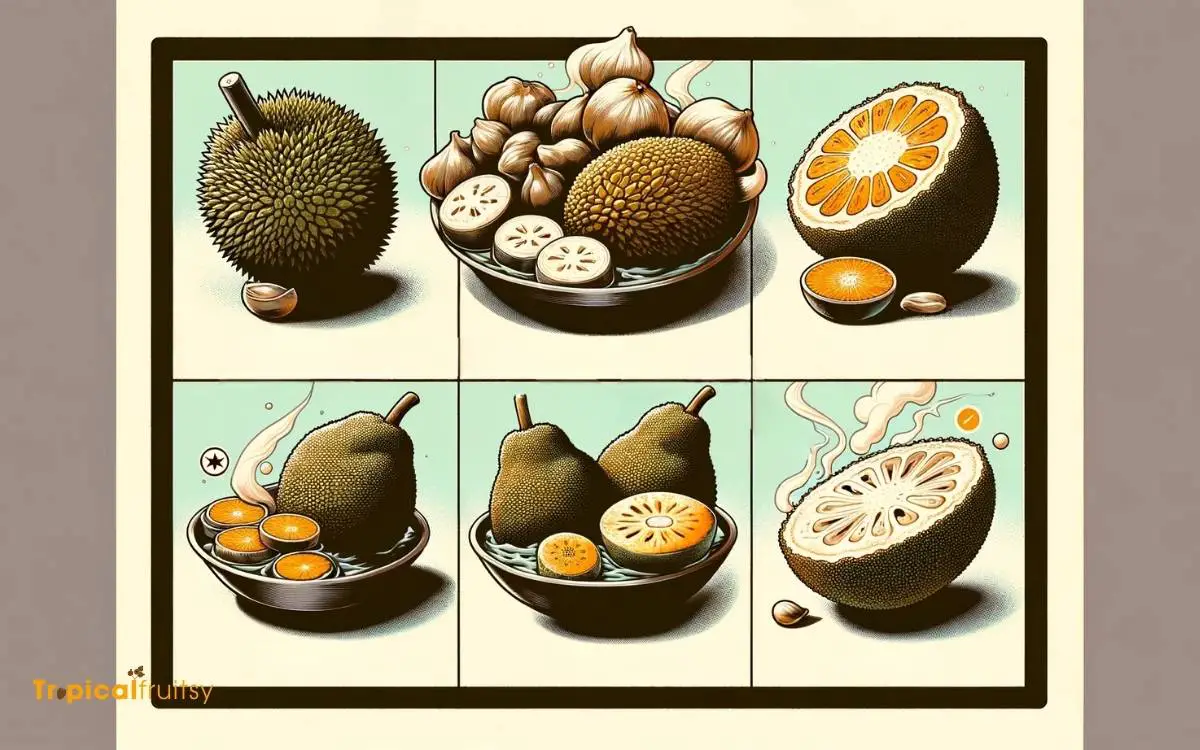What Does Breadfruit Taste Like? Explore!
Breadfruit, a staple in many tropical regions, is a versatile fruit both in its culinary applications and its flavor profile.
When unripe, its texture is starchy and firm, lending itself to a similarity with potatoes, and offering a bland, subtly sweet taste.
As it ripens, the texture softens considerably, taking on a creamier consistency, with the sweetness intensifying.
The mature fruit can evoke flavor notes reminiscent of bread, hence its name, with hints of other tropical fruits.
Its adaptability in the kitchen is notable; it can be roasted, fried, boiled, or turned into flour, making it an invaluable ingredient in a variety of dishes.
Understanding breadfruit’s taste is essential for those looking to expand their culinary palette with this nutritious and culturally significant fruit.

Key Takeaway
Unveiling the Breadfruit

Every breadfruit possesses a unique flavor profile that often draws comparisons to other staple starches, yet it maintains a distinct taste that varies with its level of ripeness and cooking method.
When immature, it exudes a subtle, vegetal sweetness, reminiscent of freshly picked corn. As it ripens, hints of banana or mango emerge, interlacing with its inherent earthiness – a complexity that beckons the palate with a tropical whisper.
Cooking transforms it further, caramelizing its natural sugars and accentuating a potato-like savoriness.
Analysis of its culinary versatility reveals that whether roasted, fried, or boiled, breadfruit adapts, presenting a chameleon-like capacity to become the canvas upon which flavors meld, making it not just a food but a culinary experience.
Texture and Consistency

While the flavor of breadfruit is rich and multifaceted, its texture is equally important, ranging from starchy and firm when underripe to creamy and soft as it matures. The transition in texture reflects its versatility in culinary applications.
Here’s how the consistency can vary:
- Underripe Breadfruit: Resembles the texture of a raw potato, providing a firm base suitable for frying or boiling.
- Ripe Breadfruit: The flesh becomes tender, adopting a texture similar to that of a ripe avocado, fitting for mashing or baking.
- Overripe Breadfruit: It turns very soft, often used in sweet applications where its custard-like consistency can truly shine.
Each stage of ripeness invites a symphony of textures, from the chewy bite of its youth to the lush, velvety smoothness of its peak ripeness, creating a culinary canvas that is both robust and nuanced.
Flavor Spectrum of Ripeness

Upon reaching varying stages of ripeness, breadfruit offers a distinct flavor profile that shifts from subtly sweet and nutty in its youth to a rich, custard-like taste when fully mature.
The journey of ripeness begins with the young fruit, which bears a resemblance to freshly-baked bread, hence its name.
This early stage is marked by a firm texture and a mellow, potato-like savor, ideal for culinary applications that favor structure.
As the fruit ripens, its flesh softens and its natural sugars develop, unveiling layers of tropical flavors reminiscent of banana, mango, or pineapple. The peak of its ripeness reveals a creamy, sweet pulp, invoking the lush essence of a dessert.
This transformative nature of breadfruit’s taste is instrumental in guiding its culinary uses and pairings.
Culinary Uses and Pairings

Numerous culinary applications for breadfruit arise from its versatile flavor profile, which pairs well with both savory and sweet ingredients. Its subtle sweetness and starchy texture make it a unique canvas for an array of dishes.
- Roasted or Grilled: When charred, the inherent sweetness intensifies, creating a smoky, caramelized exterior that complements meats or can be enjoyed as a standalone dish with a sprinkle of sea salt.
- In Stews and Curries: Breadfruit absorbs flavors beautifully, adding a satisfying heft to hearty, spiced concoctions.
- As a Dessert: Pureed or baked breadfruit can be transformed into custards, pies, or sweet fritters, often enhanced with a dusting of cinnamon or nutmeg.
Each preparation method unlocks new dimensions of breadfruit’s taste, leading us to explore how different cooking techniques impact its flavor in ‘cooking methods compared’.
Cooking Methods Compared

Exploring various cooking methods, I’ve found that breadfruit’s taste can range from mildly sweet and potato-like when boiled, to rich and custard-like when baked, highlighting its adaptability in different culinary contexts.
The transformation is remarkable—breadfruit takes on a new persona with each technique.
Frying slices until golden-brown edges emerge allows the inherent sugars to caramelize, introducing a delightful, subtle crunch and a heightened sweetness that dances on the palate.
Conversely, steaming preserves the fruit’s natural moisture content, resulting in a tender bite that holds a delicate, understated flavor, making it a versatile canvas for robust spices and sauces.
These varied preparations not only alter the taste but also the texture, showcasing breadfruit’s remarkable versatility and its ability to enliven a spectrum of dishes.
Breadfruit in World Cuisines

I’ve observed that breadfruit’s culinary adaptability extends beyond preparation methods, as it plays a distinctive role in a variety of world cuisines.
Its starchy texture and subtle sweetness become a canvas for a myriad of flavors, infused with the essence of each region’s gastronomic traditions.
- In the Caribbean, breadfruit is often roasted over open flames, imparting a smoky nuance that complements the tropical notes of jerk seasoning and marine bounties.
- Polynesian dishes celebrate breadfruit in umu pits, where it is slow-cooked with coconut cream, wrapping its flesh in a rich, velvety caress.
- In Sri Lankan kitchens, breadfruit curry graces the table, its cubes simmering in aromatic spices that amplify its earthiness and meld into a symphony of exotic warmth.
How to Tell If Breadfruit is Bad

Determining whether breadfruit is bad involves examining its appearance, texture, and smell.
Here are some signs to look for to determine if breadfruit has gone bad:
Visual Inspection:
- Check the skin: If the skin is excessively bruised, damaged, or shows signs of mold or mildew, it may be a sign that the breadfruit is no longer good.
- Discoloration: Significant changes in color, such as the flesh turning brown or black, can indicate spoilage.
- Texture: If the flesh becomes overly soft, mushy, or has a slimy texture, it is likely spoiled.
Smell:
Take a sniff near the stem end of the breadfruit. A foul or unpleasant odor, including a sour or rotten smell, is a strong indicator that the fruit has gone bad.
Firmness:
Gently press on the breadfruit with your fingers. It should yield slightly to pressure but still maintain some firmness. If it feels excessively soft or mushy, it may be spoiled.
Sound:
While not foolproof, tapping the breadfruit with your knuckles may help. A hollow sound, like tapping on a ripe watermelon, is indicative of a mature fruit. However, this method is less reliable than the others.
Mold or Mildew:
Inspect the surface of the breadfruit for any visible signs of mold or mildew. If you see any, it’s a clear indication that the fruit is no longer safe to eat.
Presence of Insects or Pests:
Check for any holes or signs of insect infestation on the surface of the breadfruit. If you see evidence of pests, it’s best to discard the fruit.
Age and Storage Conditions:
Consider how long the breadfruit has been stored and the conditions it has been kept in. Breadfruit can spoil more quickly if it’s stored in warm, humid environments.
If you encounter any of the above signs of spoilage, it’s advisable to discard the breadfruit to avoid consuming spoiled or potentially harmful food.
Proper storage in a cool, dry place can help extend the shelf life of breadfruit, but it should still be checked regularly for signs of spoilage.
Can the Taste of Breadfruit Affect What I Can Do with It?
Yes, the taste of breadfruit can significantly affect what you can do with it. If you enjoy the natural sweetness, you can use it in baking recipes. If you prefer a more savory flavor, you can explore and discover breadfruit recipes for stews, curries, and other delicious dishes.
Why Does Breadfruit Taste Bitter

Breadfruit can taste bitter for several reasons, and the bitterness can vary depending on the variety of breadfruit and its ripeness.
Here are some common reasons why breadfruit might taste bitter:
Unripe Breadfruit:
Breadfruit is often harvested and consumed at different stages of ripeness. Unripe breadfruit tends to be starchy and can have a mild bitterness.
The bitterness is more pronounced when the breadfruit is very young and not fully mature. As breadfruit ripens, it becomes sweeter and loses some of its bitterness.
Variety:
The bitterness of breadfruit can vary by variety. Some breadfruit varieties naturally have a slightly bitter taste even when ripe, while others are sweeter and less bitter. The variety you are consuming can influence the bitterness you perceive.
Skin and Latex:
The latex that oozes from the breadfruit when it’s cut can be bitter and may affect the taste of the flesh. To minimize this, some people choose to apply oil to their hands and knife when cutting breadfruit to reduce contact with the latex.
Maturity and Harvesting:
If breadfruit is harvested too early or too late, it may have a bitter taste. Harvesting breadfruit at the right stage of ripeness is essential for achieving the desired flavor.
Storage Conditions:
Improper storage can also lead to a bitter taste. Breadfruit should be stored in a cool, dry place. Exposure to high temperatures or humidity can affect its flavor negatively.
To minimize bitterness and enhance the flavor of breadfruit, consider the following tips:
- Select breadfruit that is fully ripe or at the desired level of ripeness for your intended culinary use.
- When cutting or handling breadfruit, use gloves or apply oil to your hands and knife to reduce contact with the latex.
- Cook the breadfruit using your preferred method, as cooking can help reduce bitterness.
- Experiment with different breadfruit varieties, as some may be less bitter than others.
Keep in mind that some people enjoy the slight bitterness of breadfruit, especially when used in savory dishes or as a complement to other flavors.
It’s a matter of personal taste, and the bitterness can be adjusted to suit your culinary preferences.
Conclusion
Breadfruit boasts a bountiful blend of textures and tastes, transitioning from starchy solidity to succulent sweetness as it ripens.
This versatile vegetable finds its place in a plethora of culinary contexts, contributing to diverse dishes across different cultures.
Its capacity to absorb flavors and adapt to various cooking methods marks it as a marvelous mainstay in global gastronomy, symbolizing sustenance and culinary creativity on an international scale.






